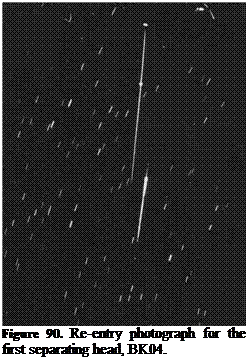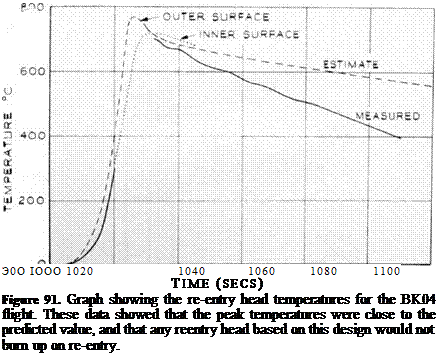BK04
Single stage. Launched 11 June 1959 at 22:33. Apogee 499 miles.
BK04, the first re-entry experiment with a separating spin-stabilised head, was very successful. The main stage reached its designed burn-out velocity and both guidance and control of the vehicle were satisfactory. Telemetry on the main stage worked throughout the flight to apogee and re-entry, and valuable information on systems performance was obtained. The head separation, turnover and spin-stabilisation system was successful. The head re-entered (200,000 ft) at 11,740 ft/second, telemetry worked throughout to impact, except for a short period during re-entry, and some information on re-entry dynamics and heating was obtained. Recovery of the head with the patches of materials under test attached to it yielded valuable information on ablation during re-entry.
The photograph in Figure 90 is a time lapse picture of the re-entry of the head and of the main rocket body. (The stars in the background appear as streaks due to the long exposure time.) This was one of the reasons Woomera was chosen for
the trials: clear skies with no cloud or smog (the flights were also scheduled for moonless nights, for obvious reasons). A further advantage of the range is that the remains of both the head and the rocket body could be collected and examined later (provided they could be found!).

 |
Data was sent from the re-entry head by radio (later heads would have a tape recorder) for analysis. The graph in Figure 91 below shows the temperature at the head of the reentry body.3 The results from the flight vindicated the choice of design: the heating was well within acceptable limits.
Although Black Knight had fulfilled its original purpose, RAE was interested in some of the other phenomena observed during re-entry, and the range at Woomera was equipped with better optical and radar equipment for the gaslight and Dazzle series of flights. The US was also interested in the results, which meant that the programme became a UK/US/Australian collaboration.
BK04 also set up the altitude record for a single stage vehicle until January 1962, when the launch of a Thor lifted an Echo-2-prototype balloon to a height of more than 900 miles.










